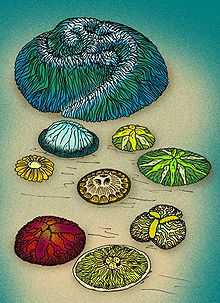Trilobozoa
- Not to be confused with trilobite.
| Trilobozoa Temporal range: Ediacaran, around 558–550Ma Ediacaran | |
|---|---|
 | |
| Scientific classification | |
| Kingdom: | Animalia |
| Phylum: | Trilobozoa Fedonkin, 1985 [nom. transl. Runnegar, 1992 ex Class Trilobozoa Fedonkin, 1985] |
| Family and Genera | |
|
See article | |
Trilobozoa ("three-lobed animals") is an extinct taxon of organisms which displayed tri-radial symmetry. Trilobozoans were most dominant during the Ediacaran period — prior to the Cambrian explosion of modern life forms.
The taxonomic affinities of this groups are open to debate. Ivantsov and Fedonkin (2002) place them among the cnidarians. They reasoned that since the conulate Vendoconularia exhibited six-fold symmetry, the conularids — then regarded as a sister group to the scyphozoan cnidarians — must be nested within the trilobozoa, making the trilobozoan group part of the cnidarian phylum.
The most primitive trilobozoans were disk-shaped, typified by Tribrachidium. Through comparisons with the other discoidal trilobozoans, it appears the different "arm" patterns on each genus/species occurred due to growth arresting or progressing at different stages of developmental growth.
The more advanced, and much longer-lasting, trilobozoans were cone-shaped, as typified by the long-lived genus Conularia, and had shell-like structures that resemble angular ice-cream cones, which tended to have four corners. However, the lack of septa or other features diagnostic of anthozoans lead researchers to disregard the conularids as being anthozoans. Ivantsov and Fedonkin posit that the conularids were ancestrally tri-radially symmetrical, as typified with Vendoconularia. Conularids are not generally thought to be a part of the Ediacaran biota, if only because of their fossil record, which began a little before the Cambrian period, and ended during the Lower Triassic. It is now also thought that the conulate trilobozoans derived their four-fold symmetry from a six-fold symmetry, as seen in Vendoconularia, which, in turn, was originally derived from the ancestral disk-like trilobozoans' three-fold symmetry.
Taxonomy
The various members of Trilobozoa are organized into (monotypic) genera, and some are grouped into families.
Family Albumaresidae Fedonkin, 1985
- Albumares Fedonkin, 1976, Suz'ma, White Sea locality; Reaphook Hill of Flinders Range
- Anfesta Fedonkin, 1984, Zimnii Bereg and Kharakta River, White Sea locality; Flinders Range
Family Tribrachididae Runnegar, 1992
- Tribrachidium Glaessner, 1959 Flinders Range; Dniester River Basin, Podolia, Ukraine; Suz'ma and Solza rivers, White Sea locality
Trilobozoa incertae sedis
The following genera are triradially symmetric edicarans that have not yet been classified into either Albumaresidae or Tribrachididae, nor a new family.
- Skinnera Wade, 1969, Mount Skinner; Flinders Range
- Hallidaya Wade, 1969, Mount Skinner
- ?Triforillonia Gehling et al., 2000, Mistaken Point
- ?Rugoconites Glaessner et Wade, 1966, Flinders Range
See also
References
- Ivantsov, A.Y. & M.A. Fedonkin 2002. Conulariid-like fossil from the Vendian of Russia: A metazoan clade across the Proterozoic/Palaeozoic boundary. Palaeontology 45(6): 1219-1229.
- Fedonkin, Mikhail A. The Rise of Animals: Evolution and Diversification of the Kingdom Animalia JHU Press, 2007 ISBN 9780801886799
- McMenamin, M.A.S. The Garden of Ediacara. New York: Columbia University Press, 1998. ISBN 0-231-10559-2
- Anatomical Information Content in the Ediacaran Fossils and Their Possible Zoological Affinities, Jerry Dzik, Instytut Paleobiologii PAN, Twarda 51/55, 00-818 Warszawa, Poland
External links
- Ediacara Assemblage University of Bristol